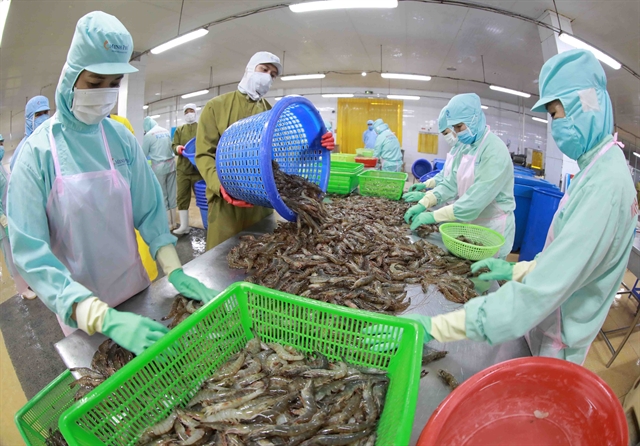 Economy
Economy


|
| A shrimp processing company in the Mekong Delta. This year, Việt Nam's aquatic product exports are forecast to rake in US$8.4 billion, equivalent to the figure in 2020. — VNA/VNS Photo Vũ Sinh |
HÀ NÔI — Vietnamese shrimp producers are accelerating production to reach their export target this year.
Shrimp processing enterprises in Cà Mau, Sóc Trăng and Bạc Liêu – the three leading localities in shrimp output and production of the country – are facing difficulties due to the COVID-19 pandemic and social distancing measures.
For the firms, it is not only difficult to circulate goods, buy and sell seed, harvest shrimp, but also causes a shortage of workers, so factories have also had to reduce processing capacity by 60-70 per cent.
Minh Phú Seafood Corporation has set a target of maintaining more than 70 per cent of their production capacity from now until the end of this year by actively applying safety measures for pandemic prevention.
A representative of Minh Phú Corporation said to achieve the target, the corporation has provided personal protective equipment for nearly 10,000 of its employees.
Currently, the demand for shrimp imports from key markets has many positive signals. The US and EU markets have eased social distancing measures, reopened and vaccines are being widely administered. Demand for shrimp imports from these markets, especially large-sized shrimp, is very high from now until November to serve Christmas.
The Ministry of Industry and Trade reports that in the remaining months this year, demand for shrimp in the European and American markets has been bouncing back. In addition, incentives on tariffs such as in the Việt Nam-Europe Free Trade Agreement (EVFTA), will continue to help Vietnamese shrimp products be competitive in the European market.
Võ Văn Sơn, Deputy General Director of Cà Mau Seafood Processing and Import-Export JSC (CAMIMEX), said his company’s nine-month export turnover was estimated at US$42 million. The remaining months will become the peak of purchasing, processing and exports for shrimp exporters. CAMIMEX will strive to obtain its export sales of between $62- $70 million for 2021.
In the first nine months this year, despite many difficulties due to the COVID-19 pandemic, his company had prepared measures to maintain production and business performance during periods of social distancing.
With flexible measures in production and pandemic prevention, shrimp processors and exporters in the Mekong Delta have come a consensus to fulfill their export targets for 2021.
Việt Nam's aquatic product exports are forecast to rake in $8.4 billion this year, equivalent to the figure in 2020, according to the Vietnam Association of Seafood Exporters and Producers (VASEP).
The export value of shrimp is predicted to reach about $3.8 billion, up three per cent year on year. Meanwhile, the export of tra fish is likely to earn $1.5 billion, equal to last year's turnover, and seafood exports are predicted to drop three per cent to $3.1 billion.
According to VASEP Vice Secretary General Nguyễn Hoài Nam, seafood production and exports will recover slowly and continue to face difficulties until the end of the year due to a lack of raw materials and labourers, and an increase in costs of labour, transport, and COVID-19 prevention.
The ratio of workers vaccinated against COVID-19 in provinces with a thriving fishery industry remains low, he noted, adding that the localities should give priority to increasing the vaccine coverage for workers in seafood production chains.
In the future, it is necessary to effectively and practically implement mechanisms and policies to support workers, especially those related to social insurance, unemployment insurance, and trade unions, Nam said.
He suggested authorities continue to support enterprises in accessing new loans, reschedule debt repayments, reduce interest rates and issue mechanisms to stabilise prices and production costs. — VNS




